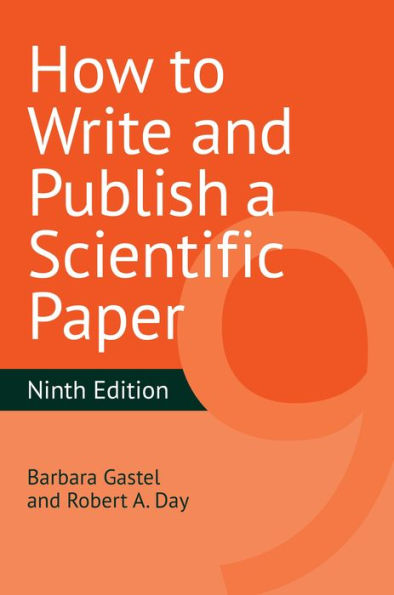

Paperback(Revised)
-
PICK UP IN STORECheck Availability at Nearby Stores
Available within 2 business hours
Related collections and offers
Overview
"The purpose of scientific writing," according to Barbara Gastel and Robert A. Day, "is to communicate new scientific findings. Science is simply too important to be communicated in anything other than words of certain meaning."
This clear, beautifully written, and often funny text is a must-have for anyone who needs to communicate scientific information, whether they're writing for a professor, other scientists, or the general public. The thoughtfully revised 9th edition retains the most important material-including preparing text and graphics, publishing papers and other types of writing, and plenty of information on writing style-while adding up-to-date advice on copyright, presenting online, identifying authors, creating visual abstracts, and writing in English as a non-native language.
A set of valuable appendixes provide ready reference, including words and expressions to avoid, SI prefixes, a list of helpful websites, and a glossary. Students and working scientists will want to keep How to Write and Publish a Scientific Paper at their desks and refer to it at every stage of writing and publication.

Product Details
| ISBN-13: | 9781440878848 |
|---|---|
| Publisher: | Bloomsbury Academic |
| Publication date: | 06/30/2022 |
| Edition description: | Revised |
| Pages: | 376 |
| Sales rank: | 888,176 |
| Product dimensions: | 6.15(w) x 9.15(h) x 0.85(d) |
| Age Range: | 12 - 18 Years |
About the Author
Robert A. Day was professor emeritus of English at the University of Delaware, Newark.
Table of Contents
Preface; A word to international readers; Acknowledgments; Part I. Some Preliminaries: 1. What is scientific writing?; 2. Historical perspectives; 3. Approaching a writing project; 4. What is a scientific paper?; 5. Ethics in scientific publishing; 6. Where to submit your manuscript; Part II. Preparing the Text: 7. How to prepare the title; 8. How to list the authors and addresses; 9. How to prepare the abstract; 10. How to write the introduction; 11. How to write the materials and methods section; 12. How to write the results; 13. How to write the discussion; 14. How to state the acknowledgments; 15. How to cite the references; Part III. Preparing the Tables and Figures: 16. How to design effective tables; 17. How to prepare effective graphs; 18. How to prepare effective photographs; Part IV. Publishing the Paper: 19. Rights and permissions; 20. How to submit the manuscript; 21. The review process (how to deal with editors); 22. The publishing process (how to deal with proofs) - and after publication; Part V. Doing Other Writing for Publication: 23. How to write a review paper; 24. How to write opinion (letters to the editor, editorials, and book reviews); 25. How to write a book chapter or a book; 26. How to write for the public; Part VI. Conference Communications: 27. How to present a paper orally; 28. How to prepare a poster; 29. How to write a conference report; Part VII. Scientific Style: 30. Use and misuse of English; 31. Avoiding jargon; 32. How and when to use abbreviations; 33. Writing clearly across cultures and media; 34. How to write science in English as a foreign language; Part VIII. Other Topics in Scientific Communication: 35. How to write a thesis; 36. How to prepare a curriculum vitae, cover letter, and personal statement; 37. How to prepare grant proposals and progress reports; 38. How to write a recommendation letter - and how to ask for one; 39. How to work with the media; 40. How to provide peer review; 41. How to edit your own work; 42. How to seek a scientific-communication career; Appendix 1. Selected journal title word abbreviations; Appendix 2. Words and expressions to avoid; Appendix 3. SI (Système International) prefixes and their abbreviations; Appendix 4. Some helpful websites; Glossary; References; Index.What People are Saying About This
"Implausibly thorough, clear, funny—everything you would want in a book on scientific writing! Follow its advice or beware the consequences…"
"How to Write and Publish a Scientific Paper is a highly desirable, up-to-date, and effective source for all the basic forms of scientific communication, essential to writing-in-the disciplines or scientific/professional writing courses and writing centers. As much for faculty as for students, it guides the reader through the whys as well as presenting the how-tos, all in readable, accessible prose. The book casts the writer in the role of decision maker—for example, not relying formulaically on IMRAD but explaining that it is one of many possible options for organization. Perhaps best of all, it promotes the basic truth that writing is essential to doing science."
"I have been using and recommending How to Write and Publish a Scientific Paper throughout my career, starting with the earliest editions. Not only is this book thorough, instructive, and fun to read, it was a critical guide in helping me to prepare manuscripts and grant applications and to hone my ability to write clear, meaningful, and easy-to-understand text. I promote this book in the many grantsmanship presentations I give each year, and I have given copies to my many trainees and to the graduate students in the PhD training program I direct."
"For almost four decades, first as a student and then a supervisor, How to Write and Publish has been my go-to resource for scientific writing. It is both informative and a joy to read; students—and academics—engage with it. It is comprehensive, and, critically, it has evolved through new editions, adapting to the ever-changing world of scientific communication. The 9th edition is no exception (for instance, it includes additions on e-publishing and the ethics of applying publication metrics). If your shelf has room for only one book on scientific writing, this should be it."
